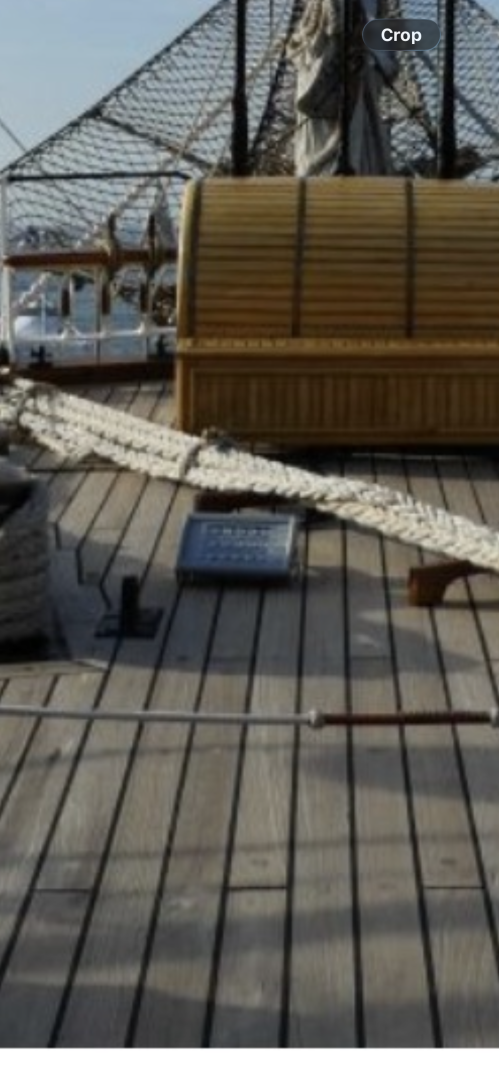-
Posts
647 -
Joined
-
Last visited
Profile Information
-
Gender
Male
-
Location
Washington State, US
Recent Profile Visitors
-
 Bill97 reacted to a post in a topic:
Amerigo Vespucci by DanielD - OcCre - 1:100
Bill97 reacted to a post in a topic:
Amerigo Vespucci by DanielD - OcCre - 1:100
-
Hi Bill, visual progress is slow for me right now as I’m doing the rigging for the bow. I’m learning how to do furled sails so have a bit of a leaning curve to overcome. I’m also having to “make my own sails” again as the ones supplied in the kit are way too thick to fold up without looking out of place. I’m using tea bag paper, very thin but ultra strong, then make the sail stitching to simulate panels, then stain the sail so it doesn’t look too white, then sew in the rope the runs around the entire sale which allows me to have attachment points for the rigging. Also, each end point that secures to a pin in a normal ship has the special AV storage at the base of each mast, so I planned for all that and it’s tedious work getting the lines tied correctly. I have a few more lines to go to finish the bow sails, so I’ll add a new photo soon.
-
Bill, sadly I’ve done something similar with my HMS Terror. At that time I placed the wiring right under the deck, which when I drilled a hole for some piece of deck equipment, I severed a wire. I had to do micro surgery by taking out a deck plank and add a hole through the false deck, find the broken wire and solder it back together and repair the deck. It was a pain to say the least. Now I don’t put the wires directly under the deck to prevent future accidents. I guess we just learn from our past and move on.
-
The way I accomplished this exact problem is making the hole in the brass the exact diameter of the body of the LED. Slide the LED from the bottom to rest on the lip and affix in place. No need to worry about the leads touching the Mount. Then I painted the bottom of the Led, the underside of the Mount, the same black as the Mount and it becomes invisible.
-
Hi Bill, if I did it again I would do it differently. I soldered about 1” of flat 3mm bar in two places on the back side of the bracket, and then cut two slots into the side of the hull. This more or less made the entire device removable, so I could work behind it, then reinstall. Worked great, except cutting the flat slots into the hull was difficult. Instead, I’d I were you, I would use brass rod, maybe 1mm diameter, and affix to the back of the bracket. Then all you have to do is drill matching holes into the hull and slide in place. Still removable, but much easier construction.
-
 LoydB reacted to a post in a topic:
Amerigo Vespucci by DanielD - OcCre - 1:100
LoydB reacted to a post in a topic:
Amerigo Vespucci by DanielD - OcCre - 1:100
-
 DanielD reacted to a post in a topic:
Amerigo Vespucci by Bill97 - OcCre - 1/100
DanielD reacted to a post in a topic:
Amerigo Vespucci by Bill97 - OcCre - 1/100
-
 DanielD reacted to a post in a topic:
Amerigo Vespucci by Bill97 - OcCre - 1/100
DanielD reacted to a post in a topic:
Amerigo Vespucci by Bill97 - OcCre - 1/100
-
 clearway reacted to a post in a topic:
Amerigo Vespucci by DanielD - OcCre - 1:100
clearway reacted to a post in a topic:
Amerigo Vespucci by DanielD - OcCre - 1:100
-
 DanielD reacted to a post in a topic:
Amerigo Vespucci by Bill97 - OcCre - 1/100
DanielD reacted to a post in a topic:
Amerigo Vespucci by Bill97 - OcCre - 1/100
-
 DanielD reacted to a post in a topic:
Amerigo Vespucci by DanielD - OcCre - 1:100
DanielD reacted to a post in a topic:
Amerigo Vespucci by DanielD - OcCre - 1:100
-
 clearway reacted to a post in a topic:
Amerigo Vespucci by DanielD - OcCre - 1:100
clearway reacted to a post in a topic:
Amerigo Vespucci by DanielD - OcCre - 1:100
-
Bill, I found absolutely nothing listed for the AV in the area of rigging. As such, I chose 3 sizes each for black and light tan. When I first bough the lines I’m using I was able to get here in the US. When I realized I didn’t have enough, I had to obtain more from China which took about a month to arrive. So…not likely a good resource anymore. The lines I am using are lightly pre-waxed so no “fuzz” and work well, just current availability is non-existent. As for the blocks, I used the ones that came in the kit but I’m modifying them to be more realistic. Hard to put into words, but I’ll try. Holding the block in a pair of needle nose pliers, sand the corners off the top and bottom creating a curved edge. Flip 180 degrees and repeat. Next grab the block with the pliers along the edges just sanded, 90 degrees from the initial sanding, and sand off the corners again. Flip 180 degrees and repeat. This rounds out the block in two plains, to make it much more realistic. Lastly, I use a triangular file and redo the grooves, top, bottom and both sides. When I get home I’ll upload an image of a before and after. It’s quite the transformation for about a minute of work.
-
 clearway reacted to a post in a topic:
Amerigo Vespucci by DanielD - OcCre - 1:100
clearway reacted to a post in a topic:
Amerigo Vespucci by DanielD - OcCre - 1:100
-
Bill, there is nothing that says the resistor has to be next to the LED, meaning, the resistor can be inside the hull and a wire from one end of the resistor goes to the LED. In my setup, I ran a series scenario with the LEDs, meaning one resistor then the LEDs are run one after the other in series. This type of wiring does have a draw back, for the same reason Christmas lights are wired in parallel now days, if one bulb goes out, they all do. That aside, the resistor is inside the hull making for less hardware in the box.
-
 DavidG reacted to a post in a topic:
Amerigo Vespucci by DanielD - OcCre - 1:100
DavidG reacted to a post in a topic:
Amerigo Vespucci by DanielD - OcCre - 1:100
-
 DanielD reacted to a post in a topic:
Amerigo Vespucci by Bill97 - OcCre - 1/100
DanielD reacted to a post in a topic:
Amerigo Vespucci by Bill97 - OcCre - 1/100
-
Bill, nothing much you can do now. My next build I will paint the inside of the hull and the underside of the deck black, then an off white so that the light will reflect around eventually coming out the port holes. The light layer will reflect most of the light, but what leaks through the black layer will absorb the light so it can’t get through to the deck, etc. turning down the intensity of the LEDs didn’t make any improvement in my case.
-
 DanielD reacted to a post in a topic:
Amerigo Vespucci by Bill97 - OcCre - 1/100
DanielD reacted to a post in a topic:
Amerigo Vespucci by Bill97 - OcCre - 1/100
-
 DanielD reacted to a post in a topic:
Sternwheeler and Barge From the Susquehanna River's Hard Coal Navy by Keith Black - FINISHED - 1:120 Scale
DanielD reacted to a post in a topic:
Sternwheeler and Barge From the Susquehanna River's Hard Coal Navy by Keith Black - FINISHED - 1:120 Scale
-
 DanielD reacted to a post in a topic:
Sternwheeler and Barge From the Susquehanna River's Hard Coal Navy by Keith Black - FINISHED - 1:120 Scale
DanielD reacted to a post in a topic:
Sternwheeler and Barge From the Susquehanna River's Hard Coal Navy by Keith Black - FINISHED - 1:120 Scale
-
 DanielD reacted to a post in a topic:
Amerigo Vespucci by Bill97 - OcCre - 1/100
DanielD reacted to a post in a topic:
Amerigo Vespucci by Bill97 - OcCre - 1/100
-
 DanielD reacted to a post in a topic:
Amerigo Vespucci by DanielD - OcCre - 1:100
DanielD reacted to a post in a topic:
Amerigo Vespucci by DanielD - OcCre - 1:100
-
Hi Bill. Yes, I drilled the port holes and installed the grommets before painting. I paint most things using my air brush so I have complete control of where paint goes. When I sprayed the colors, I sprayed at an angle, not directly into the port holes, so what little paint makes it through the opening is not directed at the midline LEDs. As for my choice in painting the grommets, the porthole frames, take a look at any image of the real AV and you will find that the porthole frames are painted the same as the surrounding hull. I also added, not included in the kit, the porthole rain gutters which were all affixed prior to painting. Hope this helps. Daniel
-
 Knocklouder reacted to a post in a topic:
Amerigo Vespucci by DanielD - OcCre - 1:100
Knocklouder reacted to a post in a topic:
Amerigo Vespucci by DanielD - OcCre - 1:100
-
 Bill97 reacted to a post in a topic:
Amerigo Vespucci by DanielD - OcCre - 1:100
Bill97 reacted to a post in a topic:
Amerigo Vespucci by DanielD - OcCre - 1:100
-
Hey Bill, I used Elmer’s Rubber Contact Cement. It is great, but it was hard to get the hang of using it so I think that is why some don’t like to use it. For me, I worked in small sections the length of the ship. Since the AV is a steel hull, there is no need to spend a ton of time making planks, so I used long plank sections from bow to stern. I started by drawing a line on the hull to place the first plank. Brush a thin coat of the cement on the back side of a couple planks and on the area along the hull for two or three planks. Let the glue dry! This is important! The glue will be dry to touch. Then carefully place a plank along the line that was drawn on the hull. Press the plank in place. Contact and pressure is what activates the glue, but it is permanent. You won’t be able to remove the plank without braking it into a bunch of pieces. Careful placement is critical! This is what makes it hard to use. However, once I got the hang of it, it was by far my favorite way to attach planks to the hull and I will use this technique on the next deck I do in the future. Again, once “pressed” in place, it’s immediately stuck and permanent and no wait time is needed between planks.
About us
Modelshipworld - Advancing Ship Modeling through Research
SSL Secured
Your security is important for us so this Website is SSL-Secured
NRG Mailing Address
Nautical Research Guild
237 South Lincoln Street
Westmont IL, 60559-1917
Model Ship World ® and the MSW logo are Registered Trademarks, and belong to the Nautical Research Guild (United States Patent and Trademark Office: No. 6,929,264 & No. 6,929,274, registered Dec. 20, 2022)
Helpful Links
About the NRG
If you enjoy building ship models that are historically accurate as well as beautiful, then The Nautical Research Guild (NRG) is just right for you.
The Guild is a non-profit educational organization whose mission is to “Advance Ship Modeling Through Research”. We provide support to our members in their efforts to raise the quality of their model ships.
The Nautical Research Guild has published our world-renowned quarterly magazine, The Nautical Research Journal, since 1955. The pages of the Journal are full of articles by accomplished ship modelers who show you how they create those exquisite details on their models, and by maritime historians who show you the correct details to build. The Journal is available in both print and digital editions. Go to the NRG web site (www.thenrg.org) to download a complimentary digital copy of the Journal. The NRG also publishes plan sets, books and compilations of back issues of the Journal and the former Ships in Scale and Model Ship Builder magazines.








